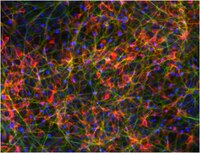ErbB2 expression increases the spectrum and potency of ligand-mediated signal transduction through ErbB4.
Wang, L M, et al.
Proc. Natl. Acad. Sci. U.S.A., 95: 6809-14 (1998)
1998
Show Abstract
Interleukin 3-dependent murine 32D cells do not detectably express members of the ErbB receptor family and do not proliferate in response to known ligands for these receptors. 32D transfectants were generated expressing human ErbB4 alone (32D.E4) or with ErbB2 (32D.E2/E4). Epidermal growth factor (EGF), neuregulin 1-beta (NRG1-beta), betacellulin (BTC), transforming growth factor-alpha (TGF-alpha), heparin binding-EGF (HB-EGF), and amphiregulin were analyzed for their ability to mediate mitogenesis in these transfectants. 32D.E4 responded mitogenically to NRG1-beta and BTC. Surprisingly, EGF also induced significant DNA synthesis and TGF-alpha was negligibly mitogenic on 32D.E4 cells, whereas HB-EGF and amphiregulin were inactive. Although coexpression of ErbB2 with ErbB4 in 32D.E2/E4 cells did not significantly alter DNA synthesis in response to NRG1-beta or BTC, it greatly enhanced mitogenesis elicited by EGF and TGF-alpha and unmasked the ability of HB-EGF to induce proliferation. EGF-related ligands that exhibited potent mitogenic activity on 32D.E2/E4 cells at low concentrations induced adherence, morphological alterations, and up-regulation of the Mac-1 integrin and FcgammaRII/III at higher concentrations. While 125I-EGF could be specifically crosslinked to both 32D.E4 and 32D.E2/E4 cells, its crosslinking capacity was greatly enhanced in the cotransfected cells. The ability of the various ligands to mediate proliferation and/or adhesion in the two transfectants correlated with their capacity to induce substrate tyrosine phosphorylation and to initiate and sustain activation of mitogen-activated protein kinase. We conclude that the ability of ErbB4 to mediate signal transduction through EGF-like ligands is broader than previously assumed and can be profoundly altered by the concomitant expression of ErbB2. | 9618494
 |










